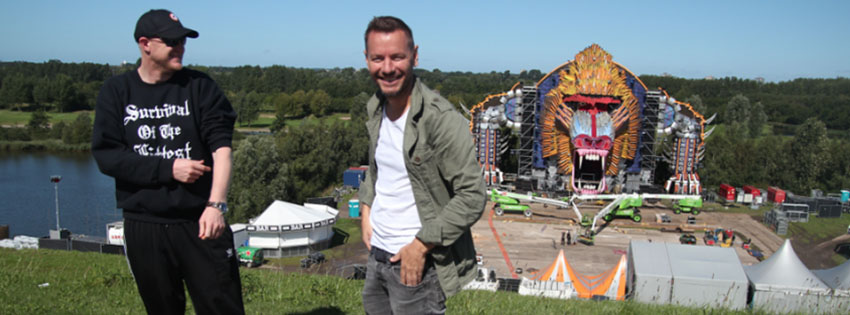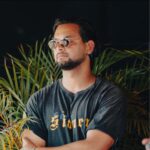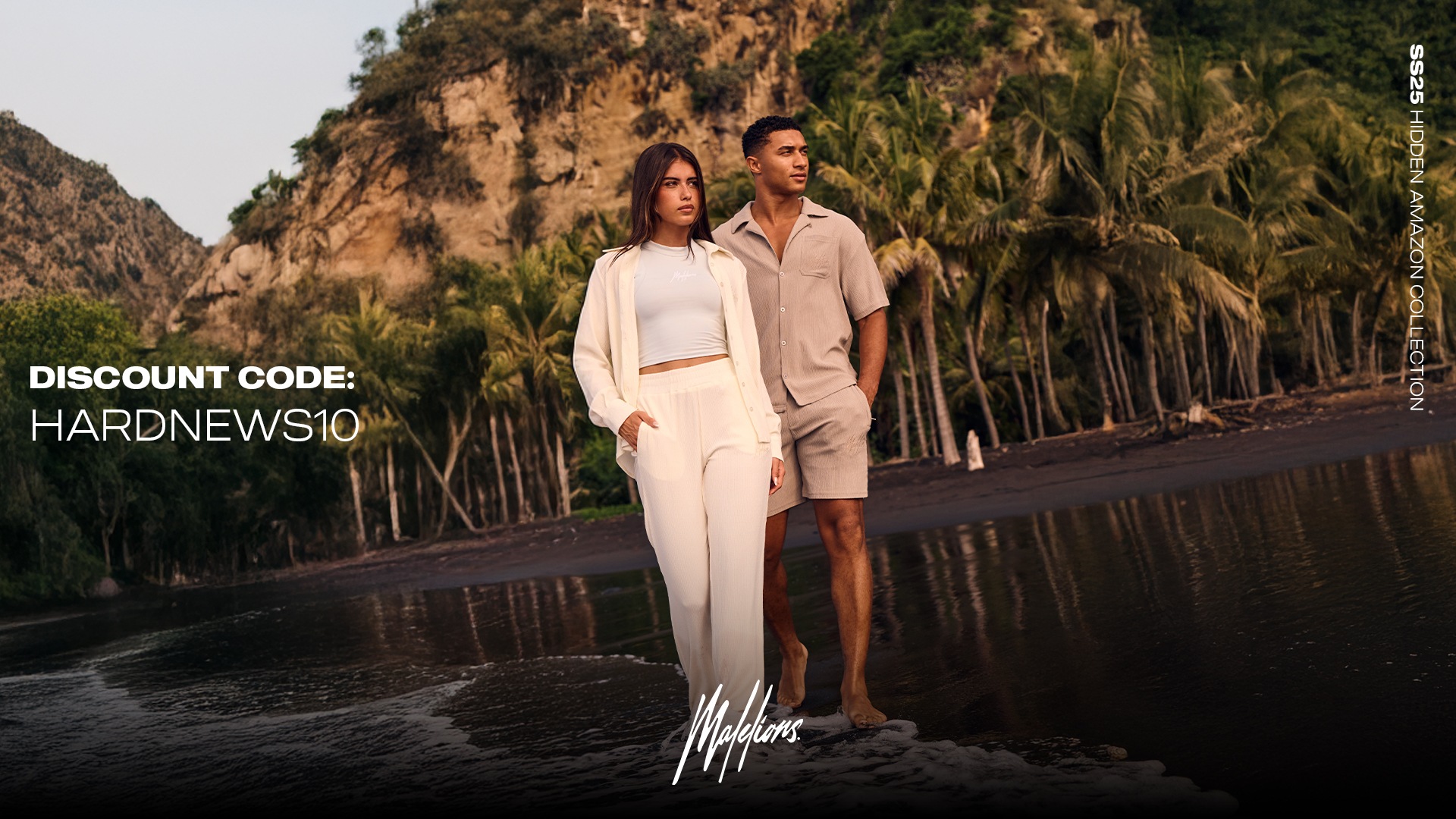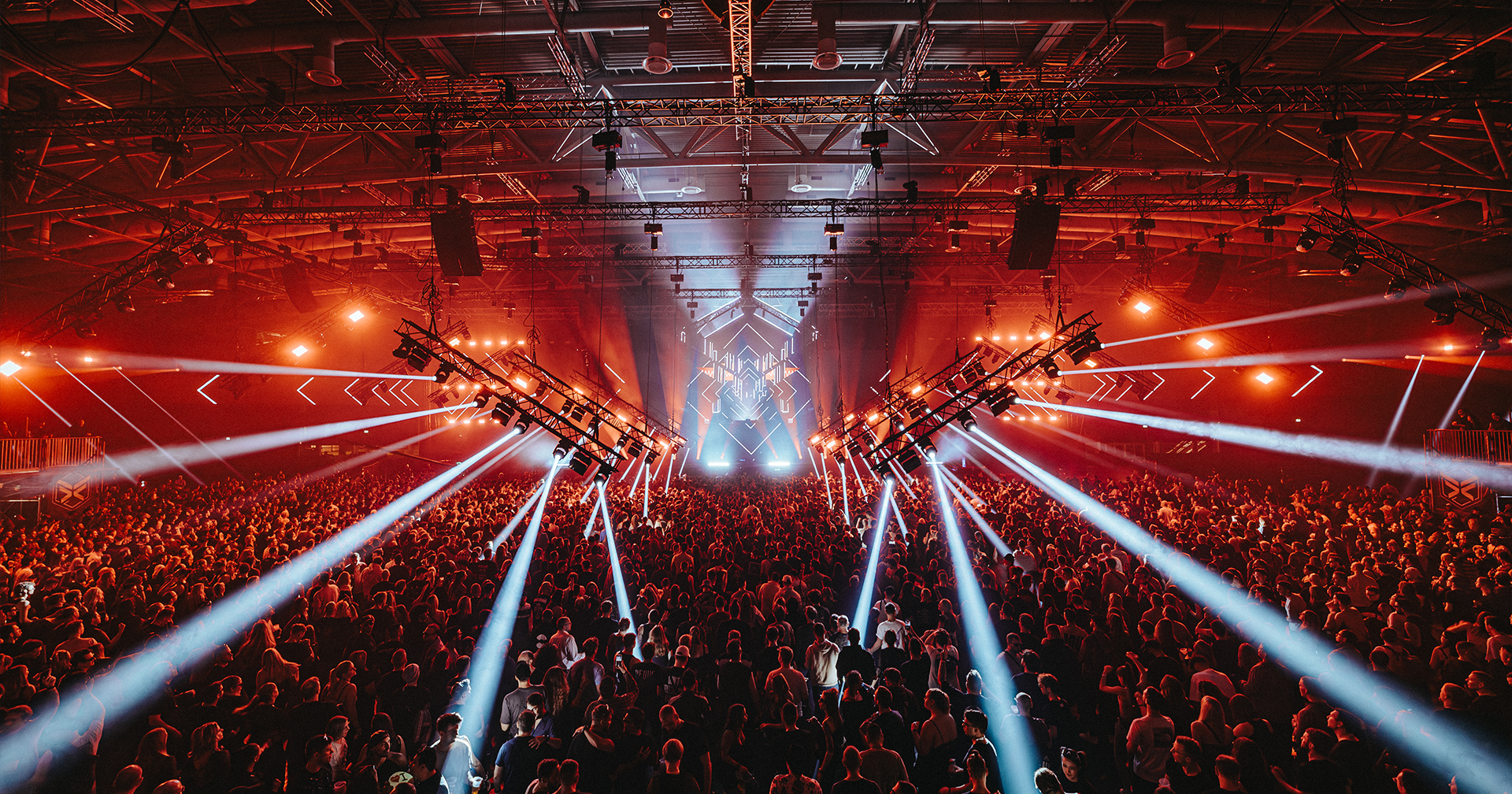Written by: Atze de Vrieze
Made for: 3VOOR12
Interview found at: 3VOOR12.nl
Thousands of phones go up, people hold their breath and then all hell breaks loose: fifteen minutes filled with fireworks, lasers, thundering voices and overwhelming music. It’s all part of the act at the biggest dance-festivalas, that close down with spectacular world-class shows. At some festivals the end shows are just as important as the headlining acts. 3voor12 brought the two most important show-experts of The Netherlands together: Jonas Schmidt (Q-dance) and Sander Vermeulen (Sensation).
He was programming until 5:30 this morning. It’s kind of his own fault though. Jonas Schmidt is the man behind the impressive Q-dance stage at Mysteryland. But that’s not all, because this year he raised his finger yet again during the meeting. “I wanted to do the mainstage as well, because I felt the end show became a little neglected the past few years.” Jonas Schmidt is a true giant. He wears a cap against the sun and a jacket with his name on it. His eyes are as small as you might expect from someone who has slept for a mere four hours, but his smile is bigger than ever. Besides that, coffee isn’t very hard to find at the backstage area of Mysteryland.
Schmidt does not only operate at Mysteryland, but he is responsible for every major known to the hardstyle-organization. Hundreds of thousands of people click on the aftermovies of events like Qlimax and Defqon.1. These events have shows of over 20 minutes that require every trick in the book.
But Sensation is also known for the same thing. Sensation, the big event in de Amsterdam ArenA, where the dresscode is white. And there is no event in the world that has such a strict dresscode. Are you wearing a red shirt? Sorry, you won’t be allowed to enter. And we couldn’t agree more, because Sensation revolves entirely about the experience. If you don’t want to join in, then you have nothing to do there. It looks beautiul, fairytale-like, and the crowd is a part of that. Chef show at Sensation is Sander Vermeulen. He came to Mysteryland to meet Schmidt, a collegue that he knows all too well, especially since Q-dance and ID&T fused together a few years ago. These two men are the most important factors behind the impressive shows on the biggest dance-festivals of The Netherlands.
How does one become creative director at Q-dance or Sensation?
Jonas: “I am one of the founders of Q-dance. I started with flyers and posters. We were eighteen years old and started hosting smaller events, that became bigger and bigger. I started doing marketing, followed by production. To be honest, I did about any job imaginable prior, during or after events. Up until I thought: and now I want to create a storyline, a feeling, a world. What once started with a theme, is now a story with a head and a tail. I’ve always been a big fan of Cirque Du Soleil, and also a big opening show at the Olympics is like ‘candyland’ for me. I see it as an art form, made by an antire team of creative people.”
Sander: “I’ve been working at ID&T for 21 years now. It all started for me when I began my design studio with the broether of Duncan Stutterheim. During the third Thunderdome Duncan got in an argument with his designer and that’s when he hired us. I had only done two classes about designing and just made my first flyer. I was eighteen at the time and had only finished elementary school.”
Is it a regular thing for you to work until 5:30 in the morning?
Sander: “Usually we start building a week prior to the event. On Monday night you hope to complete about 80%, and that’s when you can start to screw around. We’ve spent months looking at advanced 3D-sketches. Something that moves, something that opens and something that makes something pop-out, is all possible to come up with, but you won’t see it for real until you’re workin on it in the venue. We did have a moving snake in the Adam & Eve story, which looked like crap in real life. But that’s something that you can adjust along the way.”

How essential are shows for the big events?
Jonas: “It’s part of the package, a lot of people buy a tickets to witness an end show like this. Defqon.1 is our biggeest, with three days, fifteen stages and over 60.000 people. The show is so important, that we build a second moment last year, but during the day instead of at night. We called it ‘Power Hour’. It’s a real challenge, because you can’t impress the crowd with light of lasers, so you bring in other show elements.”
Sander: “Tomorrowland in Belgium exploded because of one aftershow video. They had an impressive stage and were prepared to pay € 800.000 for the DJ’s. They had everything.”
Jonas: “They stuck their head out at the right time. They were thinking: let’s do it!”
Sander: “And you gotta hand it to them: they invest their money back into the event. You can’t say that of everyone.
Jonas: “Sometimes people complain about the aftermovies, saying: how lame, nobody is dancing, everybody is recording it with his phone. I don’t mind, because we design our show for that purpose. They’ve been dancing all day, now they deserve a moment to relax and be impressed.”
Sander: “But all those LED-lights are pretty annoying..”
Jonas: “Yeah I agree, but I made peace with it. It’s a way for people to prove that they were actually there.”
Sander: “That’s true, we are a part of the experience economy. You don’t impress with a car, but by showing a video on Facebook. Would you look at that, I’m at Mysteryland.”
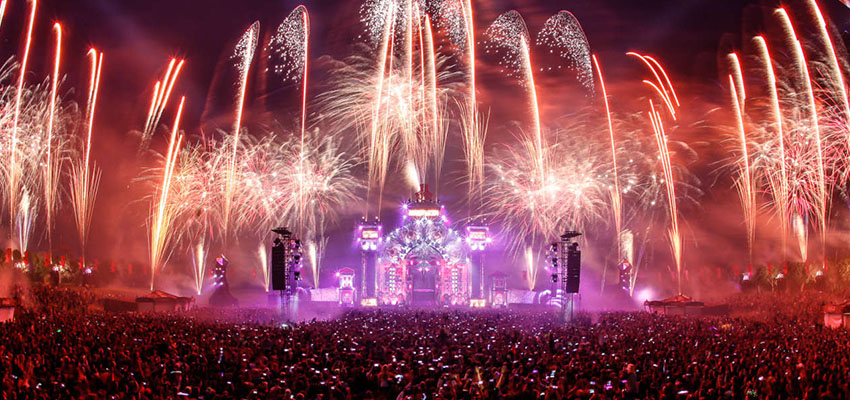
How do you take on a show like that?
Jonas: “It can go in any direction. Sometimes there is an idea that gets translated to music, sometimes it’s the other way around. Last week I talked to Martin Garrix about the closing set at Mysteryland. I asked him: do you have something special that we can work with, a new record for example? Well, he sure did. But an end show is something different. I asked him if he could adjust the intro, but eventually we did it ourselves because he was too busy. During the first five minutes you’ll hear his new track, followed by his track “Virus”, and in the meantime we shoot about halve a Chinese fireworks factory up in the air.”
Sander: “Fireworks are a part of it, but we also try to come up with other things. At Sensation we’ve had a lot of discussions about my proposition to hire an orchestra and a choir with thousand people. It’s way too expensive for those few minutes. Eventually the orchestra died off and we were left with an orchestra of 500 people. Afterwards the crowd started clapping. And people only do that if they’re really overwhelmed. That is the highest possible achievement for us, next to tears of course. Those moments really touch people. The music, a drink and something else helps with that of course. People are open for it.”
Jonas: “Those shows have become a huge thing. People really go look forward to it. That makes it even harder to surprise them. One time at Qlimax we did that with somewhat of a resersed-theorie. You expect a build-up towards something really cool, but in fact we started out really hard and eary. The entire venue was trembling, you really had the feeling of standing in an oven. The best thing we could do after that was: turn down everything. The lights, the music, everything. You could hear a sigh going through the entire GelreDome. That feeling is awesome. And from that moment you build on, because you can’t let people freeze.”
That’s something you won’t be able to do at Sensation
Sander: “No that’s right, it’s a shame. The devil is always more interesting than the angel. We used to have Sensation Black, and we played with the gods of heaven and hell, saints and sinners.”
So how do you keep things exciting, when white is your only ‘colour’?
Sander: “We brought more edge. And you need to make sure that you stay away from the cliche. Around 2012 we saw that a lot of other events were copying our intro’s. That’s when we decided to make a change. We created huge masks, on which we projected the face of a man. We then used an old housetrack of Lil Louis, “Blackout”, and the actor had to put his head in a vise in order to keep still. We really made the intro come to live.”
What’s the best idea ever from Sensation?
Sander: “That’s a tough question. In 2011 we had luminous balls hanging from the ceiling. During the second intro they started to light up, and at the third intro they suddenly came down from the sky. One of our light operators saw something like that at the World Expo in Shanghai and made a video of it. We went to look at it ourselves and on the way back in the plane we were already drawing six-hundred balls. That quickly became three-hundred and eventually one-hundred-and-eighty. But that was just the right amount. ”
Jonas: “To give you an idea about how ideas come to life: the last edition of Defqon.1 we had a plan to attach to bungee jump cranes to the mainstage. I thought it would be cool, to tell your friends. Eventuallly the plan got rejected. It wasn’t high enough, it would be too much of a distraction, ‘you’ve lost your mind’. But when I was looking at the early drawings a while after that, I thought to myself: what if we put fireworks in those cranes, to make them look like golden wings. The stage would transform from 100×30 to 200×40 meters!”
What is something you’d love to do someday, but is not yet possible?
Jonas: “I would love to put moving heads on fifty drones, and make them ascend from behind the stage. Really, if that would be possible then forget about the fireworks. I think it’s possible, but it’s an expensive hobby. Those guys from Cirque Du Soleil can easily spend 2 million on their show and work on it for three years. But to them it’s worth it, because they will perform that show many times. It’s awesome, to sit in your seat, which tilts over, the roof opens and you look at an entire galaxy worth of drones. The technology evolves at an incredible speed. Each month the market is flooded with new lights. And the same goes for lasers, stages, moving parts, everything.”

Sander, you don’t develop your show for a single night. That’s an advantage. But in the same time you can’t exactly design a show for let’s say the ArenA.
Sander: “That’s correct, we have to make concessions. We’ve dealt with the most bizarre venues around the world. In Brasil we had a huge venue in the shape of your laptop. It was barely 14 meters high, but it had room enough to fit 100.000 people. The tree we had that year, looked more like a weeping wild.”
Jonas: “I had to fill in for you right? I came all the way from Defqon.1 in Australia and had never been as jetlagged as I was back then. It was an intense edition, which sold-out in no-time and had an important sponsor. Sensation was exploding around the world at that time. I remember arriving at the venue while there was some crazy party still going on in another part of it. They had a band and went on until 5:00. So I had to program the show with all that noise. And I screwed up, because at 5:30 when we finally had the chance to turn on the music, I blew up the speakers. The next day we had to program the entire thing four hours prior to the event. It was a true Sensation-worthy show. The sponsor could also be happy, because we highlighted our fountains with a yellowish colour to make it look like beer. I thought people weren’t dancing, but Duncan took me with him to the crowd and everybody was in shock “what the fuck.”
Sander: “I had the exact same thing in Brasil. It looked very calm, unlike Chile, but when you looked closer you could see why. People were dancing with their hips, not with their heads.”
What has been your ultimate spinal tap moment?
Jonas: “Oh, we had so many. But I still remember one time with DJ Luna. We built an entire show around him. After an elaborate intro he would come down from the ceiling. But, three meters above the stage he got stuck. He was hanging there for ten minutes before people were able to get him down.”
